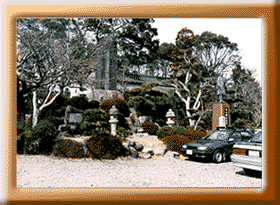
Satsuma Heroes
` Satsuma Hanshi ( samurais who belong to Satsuma )Ethe general headquarters | a site of their office `

£ Omaki, a site of the office of the construction for Satsuma Hanshi
( a place of a general administrator Yukie HIRATA's death )
On Feburary 25th of the 3rd year of the Horeki era ( 1753 ). Ieshige TOKUGAWA, of
the 9th shogun ( a general ) told Satsuma Hanshi to do embankment works of the Kiso river.
On January21st of the 4th year of the Horeki ( 1754 ), the advance party left for Mino
from Edo. Then on January 29th, Yukie HIRATA and his party left for Mino from Satsuma.
On Feburary 9th they reached Omaki Yoro Town Yoro County Gifu Prefecture. After their
arraival, they rented a building which was belonged to Heinai KITO, a rich farmer at Omaki
as a place of the general headquarters of embankment works. They repaired and used it as
their office,and called it Moto-goya ( a main office).
The main office was in Heinai KITO's land. His lot had an area of 4900 tsubo ( about1.6
hectare). At present it has only one-third the area at that time. Besides the main office,
they established five branch offices at five places - Mr. Kindayu a village headman's land
at Ishida Shimonakajima Village Hshima County, Mr. Heidayu a presant's land at
Nishitaikaichi Kisozaki Kuwana County, Mr.Genzo a village headman's land at Kanemawari
Kaizu Town Kaizu County, Mr. Buheiji a village headman's land at Ishizu Village Kaizu
County and Mr. Kanwemon WATANABE's land at Oyabu Wanouchi Town Ampachi
County. And they got 12 umamawari ( cavaliers ), 36 hokoshi ( samurais who don't have
their own horses ) and a few ashigaru (samurais who are in the lowest class), and directly
supervised the construction at these offices. In total there were 947 samurais who came
from Satsuma in Mino including samurais who were sent there additionaly apart from the
member on the notification.
It is said that as many as 2000 people worked there adding to the people who lived in
Mino. The four sections of construction which were planned by the Satsuma and the shogunate
is as follows :
the first section Sofue Town Aichi PrefectureESimmeizu waju ( a place surrounded by
banks ) `Kuwabara Town Hashima City Gifu Prefecture EKoyabu waju
the second section Yatomi Town Ama County Aichi PrefectureEMoritsu waju ` Kisozaki
Town Kuwana County Mie PrefectureETashiro waju
the third section Ampachi County Gifu PrefectureESunomata waju ` Kaizu Town
Gifu PrefectureEHonnami-shinden waju
the fourth section Kaizu Town Gifu PrefectureEKanemawari waju ` Jizoguchi Kuwana
City Mie Prefecture
They started these construction on Feburary 22nd of the 4th year of the Horeki era and
finished them on March 28th the next year. On May 24th Yukie HIRATA wrote a letter to a
karo ( a samurai who is in the highest class ) in Satsuma that mainly informed they
smoothly finished the every construction on May 22nd and had already given it up to the
shogunate. And he reported about that to a gard of Satsuma. On May 25th he worshipped the
rising sun in the eastern sky at the office and prayed heartily his lord Takamori SAIGO,
facing the west.
uSumi nareshi Sato mo imasara Nagori nite Tachizo wazurau Mino no Omakiv
(Thouth I've still felt sad to leave my hometown, I'm also sorry to part from Omaki in Mino)
He left g jisei no ku ( a Japanese poem of 31 syllables in his last moment ) has
mentioned above. Then he assumed all his responsibility on himself and died a heroic but
tragic end. An ashes of Yukie HIRATA who died at the age of 52 was taken to Kuwana
along the Ibi river. Then it was enshrined over night at the Anryu-in ( at Tsutsumihara
Kuwana City Mie Prefecture ).The next morning it was carried to the Daikoku temple in
Kyoto Fushimi along the Tokai Street at once and was burried there. As the Anryuin had
fallen into ruins since then, other people have burried again in the Kaizo temple
belonging to the same Sodo religion as the Anryu-in.



Ogaki Seinen Club e-mail address
scogaki@mb.gi.net.or.jp